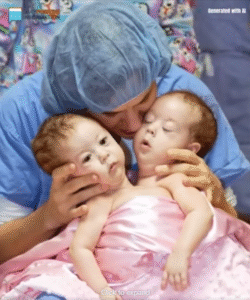Split to Soar: The Herrin Twins and the Art of Becoming Whole
In 2006, the world watched with bated breath as a team of surgeons in Utah undertook one of the most complex and emotionally charged operations in pediatric history. Kendra and Maliyah Herrin, born conjoined at the abdomen, shared a liver, a kidney, and a pelvis. At just four years old, they were about to be separated—a procedure that would not only divide their bodies but redefine their futures.
The surgery lasted 26 hours. Six surgeons. Twenty-five support staff. One kidney to share. And two little girls who had never known life apart.
It wasn’t just a medical feat. It was a leap of faith.
🧠 The Anatomy of a Miracle
Conjoined twins are rare—occurring in roughly one in every 200,000 births. Separation surgeries are rarer still, and fraught with risk. In Kendra and Maliyah’s case, the stakes were even higher. Because they shared a single kidney, one twin would be left without. That twin was Maliyah.
The decision to proceed wasn’t taken lightly. Their parents, Erin and Jake Herrin, agonized over it. But they believed in their daughters’ right to live full, independent lives—even if it meant facing dialysis and future transplants. They chose hope over fear.
And the girls? They chose each other.
🧵 The Fabric of Sisterhood
Growing up conjoined meant learning to move in sync. Each girl controlled one leg. They had to coordinate every step, every turn, every gesture. Their bodies were one—but their minds, their personalities, their dreams were distinct.
Kendra was more reserved. Maliyah, more outspoken. They bickered like any siblings. They laughed like best friends. And when the time came to separate, they understood what it meant—not just physically, but emotionally.
They were about to become two.
But they never stopped being one another’s anchor.
🏥 After the Cut: Healing and Becoming
Post-surgery, Maliyah began dialysis. She later received a kidney transplant from her mother. Both girls had to learn to walk again—this time, each with one leg. They used crutches, wheelchairs, prosthetics. They fell. They got back up.
And slowly, they began to live separately.
But separation didn’t mean isolation. They remained inseparable in spirit. They shared bedrooms, secrets, inside jokes. They navigated school, friendships, and adolescence side by side.
Their bodies had changed. Their bond hadn’t.
🌟 Life in the Spotlight
The Herrin twins became public figures almost overnight. Their story was featured on Oprah. Documentaries followed. Their mother wrote a book. Strangers recognized them in grocery stores. Some stared. Some asked questions. Some took photos without permission.
It wasn’t always easy.
But Kendra and Maliyah chose openness. They spoke about their experience. They advocated for kindness, inclusion, and respect. They reminded people that disability isn’t a tragedy—it’s a different way of being.
And they asked for one simple thing: “Be nice.”
🎓 Growing Up, Growing Apart
By 2019, the girls were high school seniors in Utah. They had grown into confident, articulate young women. Each had one leg. Each had her own dreams. They were learning to drive. They were thinking about college. They were imagining futures that didn’t always overlap.
And that was okay.
Because growing apart didn’t mean growing away.
Their friendship circle was tight. Their faith community supportive. Their family, unwavering. They had built lives that honored both their shared past and their separate paths.
They were no longer conjoined. But they were still connected.
🧠 The Psychology of Identity
What does it mean to be born fused to another person? To share organs, space, movement? And then, to be separated—to become your own body, your own name, your own story?
For Kendra and Maliyah, identity has always been layered. They are twins. They are survivors. They are individuals. And they are symbols—of resilience, of medical possibility, of what it means to grow into yourself.
They’ve had to answer questions most people never face. About autonomy. About visibility. About difference.
And they’ve done so with grace.
💡 Lessons from the Herrins
Their story teaches us that wholeness isn’t about symmetry. It’s about authenticity.
That independence isn’t the absence of connection—it’s the freedom to choose it.
That disability isn’t a limitation—it’s a lens.
And that love—between siblings, parents, communities—can carry us through the most daunting transformations.
Kendra and Maliyah didn’t just survive separation. They redefined it. They showed the world that becoming separate doesn’t mean becoming less.
It means becoming more.
🕊️ A Future Unfolding
Today, the Herrin twins are young adults. They live full lives. They pursue passions. They face challenges. They celebrate victories. They continue to inspire.
Their story isn’t over. It’s evolving.
And as they step into adulthood, they carry with them not just the scars of surgery, but the strength of survival. Not just the memory of being conjoined, but the miracle of being whole.
They are proof that transformation is possible. That healing is real. That love endures.
And that sometimes, the most powerful journey is the one from together to apart—and back again.



